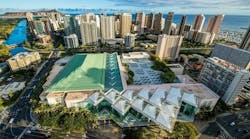The Hawai‘i Convention Center is celebrating its recent Gold certification in LEED v4 O+M: Existing Buildings by launching the Hoʻomaluō Program, a comprehensive approach to environmental sustainability with the goal of enhancing the guest, planner, staff and community meetings and events experience.
Hoʻomaluō, which means “to conserve; to use or manage wisely” in the Hawaiian language, celebrates the center’s recent award of LEED v4 O+M: Existing Buildings Gold Certification by the U.S. Green Building Council.
The Hawai‘i Convention Center is the first and only public assembly building of its kind to earn LEED v4 O+M: Existing Buildings Gold in the U.S., and is the only LEED v.4 O+M Gold project in Hawai‘i.
(Photo: Hawaii Convention Center Credit: Cameron Brooks)
Canvas sails on the rooftop are a visual clue that the convention center is managed in a way that respects the environment. The sails allow Hawaii’s trade winds to circulate throughout the building, providing passive air conditioning and venting excess heat out of the building naturally.
“At the Hawai‘i Convention Center, our guests, planners, staff and communities have come together for more than two decades to preserve, protect and enhance the natural beauty of the Hawaiian Islands,” says Teri Orton, general manager of the Hawai‘i Convention Center.
14 Sustainable Solutions
Inside, a host of sustainable solutions ensures that the convention center performs efficiently and keeps guests comfortable. Here are 14 they used:
1. The building management system monitors electricity use and pre-cools meeting rooms according to programmed meeting start and end times. The lights turn off whenever meeting room activity stops. Lighting and air conditioning in the back-of-house areas are turned off during weekends and holidays.
2. A smaller jockey chiller with lower capacity replaced the original larger chillers. It can provide efficient cooling during periods with reduced loads.
3. Lighting retrofits replaced inefficient lighting in the ballroom, exhibition halls, parking areas and back-of-the-house offices and hallways with more efficient configurations and lamp types.
4. Variable frequency drives on large equipment adjusts motor speeds as needed.
5. Touchless technology, including sink faucets with sensors and automatic dispensers for hand towels, hand soap and hand sanitizer, reduces restroom supply demands.
6. Low-flow toilets and urinals and low-flow aerators for sinks and showers reduce the center’s water use.
7. The landscape utilizes xeriscaping and drip irrigation to minimize the water requirements for the grounds.
8. Staff members use self-pedal bicycles, electric carts and propane-powered lifts to get around. That reduces the center’s use of petroleum products and also improves air quality.
9. Electric vehicles have designated EV parking, as well as a charging station that both guests and staff can use.
10. Staff collect and sort glass, plastic, aluminum, paper and cardboard through the center’s comprehensive recycling program. Meeting rooms, public areas, convention offices and all food and beverage stations feature recycling receptacles to make participation easy.
11. Green waste left over from landscaping is composted and recycled into mulch.
12. The housekeeping, landscaping, engineering and food and beverage departments purchase eco-friendly chemicals.
13. Procurement policies take ENERGY STAR ratings and other industry certifications into consideration when it’s time to upgrade equipment and appliances. Sustainable building materials are also included in the selection process for all capital improvement projects.
14. The single-use food and beverage service ware is biodegradable and compostable.
“At the Hawai‘i Convention Center, our guests, planners, staff and communities have come together for more than two decades to preserve, protect and enhance the natural beauty of the Hawaiian Islands,” says Teri Orton, general manager of the Hawai‘i Convention Center. “This LEED certification nationally recognizes the dedicated work of our staff to make our Hoʻomaluō Program a reality. Since our opening 20 years ago, the Hawai‘i Convention Center has been deeply committed to a multifaceted approach to environmental conservation that inspires everything we do and touches everyone we serve.”
The holistic Hoʻomaluō Program encompasses the center’s work to conserve and reuse resources; maintain a high quality of operations, such as climate, guest comfort and building design; and pay careful attention to reducing waste throughout each stage in the event process.
[Related: Zero Waste Tips for Event Venues]
It formally kicks off in conjunction with the 2018 American Dental Association (ADA) – America’s Dental Meeting, held Oct. 18-22. The 1.1 million-square-foot center will host over 15,000 registrants from 46 countries for the meeting, which is expected to generate an estimated $70.8 million in statewide visitor spending.
The American Dental Association has also committed to reforesting 100 legacy trees through the Hawaiian Legacy Reforestation Initiative, a nonprofit organization that has led the reforestation of more than 340,000 endemic tress on Hawai’i Island. The Hawai’i Convention Center has committed to planting 1 million native trees across the state.
“As contributing members of our community, both professional and personal, we are always working to give back to the public,” said Jeffrey M. Cole, D.D.S, ADA president-elect. “Our organization’s vision is helping the public achieve optimal health, so it made sense to participate in this effort. The Hawaiian Legacy Reforestation Initiative and Hawai‘i Convention Center offer a unique opportunity to offset our carbon footprint in traveling here and to help keep the islands that we love pristine and picturesque for years to come.”
Janelle Penny, Senior Staff Writer of BUILDINGS, contributed to this article.
Two handpicked articles to read next:



